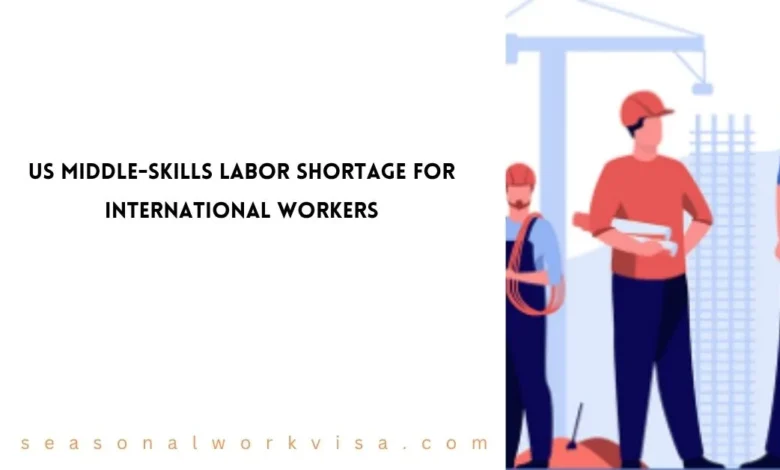US Middle-Skills Labor Shortage For International Workers

The U.S. economy is undergoing a quiet crisis in 2025, but for foreign job seekers, it might be the perfect opportunity they’ve been waiting for.
Growth in important American businesses is in danger of being halted by a startling lack of middle-skilled workers, or those prepared for occupations that need more than a high school education but less than a university degree. The twist is that foreign skilled people are being considered as a way to keep the economy growing.
Over 1.2 million middle-skill jobs in the United States are unfilled, costing the country a staggering $150 million a year in lost production and efficiency, according to a startling estimate that was published in the Spring 2025 edition of Career Education Review.
What’s at Stake?
The core of the American workforce consists of middle-skilled occupations in vital domains such as
- Healthcare
- Construction
- Electrical and HVAC systems
- Advanced manufacturing
- Technical services
These positions include phlebotomists, HVAC technicians, electrical technicians, and medical assistants—critical occupations that keep America functioning but are currently beset by a chronic lack of skill.
Read Also: Differences Between a Green Card and US Visa
Why International Workers Should Pay Attention?
For foreign workers, the United States’ expanding labor shortage—especially in middle-skilled industries—offers a substantial opportunity. These positions are accessible and fulfilling for many individuals from across the world since they do not require a four-year college degree and instead place an emphasis on practical skills, certifications, and vocational training.
Key Reasons to Take Notice:
- Fast-Track to Employment
Without the need for costly, time-consuming degrees, middle-skilled occupations (such as those in healthcare, infrastructure, logistics, and technology) provide quicker entrance into the workforce through short-term training or vocational programs. - Pathway to Immigration Sponsorship
Many of these positions are in highly sought-after industries, which raises the possibility of employer-sponsored visas like TN (for eligible applicants from particular nations), EB-3, or H-2B. - Global Demand for Skills
“This is not just a labor gap—it’s an open invitation to global skilled workers to help power America’s infrastructure, healthcare, and tech systems,” said Scott M. Shaw, president and CEO of Lincoln information. - High Earning Potential & Job Security
Particularly in fields like advanced manufacturing, information technology, and healthcare assistance, middle-skilled positions frequently offer competitive pay, health benefits, and opportunities for long-term professional advancement. - Supportive Training Ecosystem
Programs designed for international students are offered by organizations such as Lincoln Technical Institute and other trade schools in the United States; these schools frequently have connections to companies and help with job placement.
List of Top Jobs Under This Report’s Radar in Urgent Demand in US in 2025
| Career Path | Median Salary (USD) | Why It’s in Demand |
|---|---|---|
| Medical Assistant | $35,000 – $55,000 | Rising healthcare demand, aging population |
| HVAC Technician | $45,000 – $70,000 | Climate-driven need for efficient systems |
| Electrical Technician | $50,000 – $75,000 | Infrastructure and smart tech expansion |
| Phlebotomist | $35,000 – $55,000 | Crucial for diagnostic healthcare |
These occupations are perfect for future-proof careers because they not only offer steady pay and job stability, but they are also less vulnerable to automation and outsourcing.
The Immigration Pathway is Open!
For foreign workers, the persistent labor shortage in middle-skilled industries across the United States offers a straightforward and convenient immigration route. There are several visa and residence alternatives to help you start a career in the United States, regardless of whether you have any prior work experience or are just beginning your vocational training.
Immigration and Visa Routes for Skilled International Workers:
- M-1 / F-1 Visas – Vocational & Technical Education
- for students starting technical or vocational schools in the United States.
- M-1 is for vocational courses; F-1 is for academic and language training programs.
- Under these visas, international students are admitted to institutions such as Austin Career Institute and Lincoln Tech.
- Optional Practical Training (OPT)
- accessible to holders of F-1 visas following graduation.
- offers a maximum of 12 months of work experience in the United States, or 24 months for STEM disciplines.
- provides a vital first step toward company sponsorship.
- H-2B Visa – Seasonal or Temporary Skilled Work
- for non-agricultural positions in sectors such as maintenance, construction, and hospitality.
- may lead to both short-term, lawful work and possible long-term prospects.
- EB-3 Green Card – “Other Workers” Category
- for low-skilled or inexperienced personnel (less than two years of experience is required).
- provides a direct route to permanent residence in the event that a U.S. business sponsors it.
- One of the most practical options for foreigners without a college degree.
- J-1 Visa Trainee Programs
- For professionals with trade skills or young graduates looking for practical U.S. experience.
- frequently consists of organized training and internship programs in collaboration with US businesses.
Thousands of domestic and foreign students are already trained by organizations like Austin Career Institute and Lincoln Tech, many of whom go on to obtain jobs and sponsorship for their visas.
What’s Driving This Crisis?
Years of structural trends have weakened the pipeline of vocational talent, resulting in a rising lack of trained people in the U.S. in industries including trades, healthcare, and infrastructure. The following are the main causes of the crisis:
1. Mass Retirements of Baby Boomer Tradespeople
- Many members of the Baby Boomer generation, who occupied many skilled trade positions, are retiring.
- There is no one to take their place as fewer young people are pursuing careers in the trades.
- The result is a fast-growing deficit in experienced labor.
2. Cultural Emphasis on 4-Year Degrees
- College education has been heavily marketed by society as the “best” job route.
- Technical and vocational occupations have been misinterpreted or underappreciated.
- Despite providing good compensation and job stability, this has resulted in a shortage of workers in several vital hands-on industries.
3. Underfunded High School Vocational Programs
- In many public schools, shop classes, automotive training, and technical programs have been cut back or discontinued.
- This limits opportunities for pupils to acquire trade skills during adolescence and denies them early exposure to practical careers.
4. Decline of Union Apprenticeships
- In the past, labor unions were crucial to the establishment of apprenticeship programs and organized training for trade occupations.
- This dependable method of developing skilled workers has diminished along with union power.
- Nowadays, many workers do not have access to formal, reasonably priced training.
What’s Next?
In response, states are updating their curricula in collaboration with industry and redesigning Career and Technical Education (CTE) programs. In the meantime, social media is reviving trade careers as technicians, electricians, and welders post their work on Instagram and TikTok, changing the perception of skilled trades.
International workers are urged to move swiftly because the path is quicker and more affordable than ever before, the demand is genuine, and the pay is competitive.
References
- https://austincareerinstitute.edu/blog/trade-school/addressing-the-middle-skills-workforce-shortage/
Conclusion:
A call to action for skilled international workers: the middle-skill labor shortfall in the United States is more than just a domestic issue. Now is the moment for overseas candidates to take advantage of this once-in-a-lifetime opportunity, which includes over a million open positions, competitive pay, options for visa sponsorship, and realistic career paths. America’s workforce needs you, whether you’re a healthcare assistant, skilled technician, or vocational student. Take immediate action, receive training, and join the team driving the U.S. economy’s future.
Frequently Asked Questions
What are middle-skilled jobs in the U.S.?
Middle-skilled jobs are roles that require more training than a high school diploma but less than a four-year college degree. Examples include HVAC technicians, medical assistants, and electrical technicians.
Why is there a shortage of middle-skilled workers in the U.S. in 2025?
Mass Baby Boomer retirements, a societal preference for college degrees, underfunded vocational programs, and a fall in union-run apprenticeships are some of the contributing factors.




